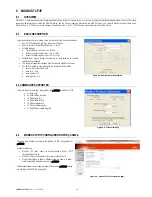
pCOWeb
+030220966 – rel. 1.1 – 12.12.2017
38
7.1
BACnet/Carel Mapping
For each
pCOWeb
that interfaces to a Carel controller using a standard Carel
pCO
connection there can be a maximum of 670 BACnet objects, which
include the Device Object. Of the 670 objects, there are always 16 Notification Class objects, 16 Calendar objects, 16 Schedule objects and there can be up
to 207 Analog Values, 207 Analog Values or Multi-state Values and 207 Binary Values. The number of each type can be configured prior to use. From the
factory all 621 Analog Value and Binary Value objects are mapped. Object_Identifiers are assigned according to the following table:
Object Type
Instance Range
pCO
Mapping
Analog Value
1-207
A001-A207
Analog Value or Multi-state Value
1001-1207
I001-I207
Binary Value
1-207
D001-D207
Table 7.a – BACnet/Carel mapping
From the factory, I001-I2007 are mapped as Analog Value 1001-Analog Value 1207. Each of these may be reprogrammed as Multi-state Values on an individual basis,
by writing to the Object_Identifier property. BACnet objects which are mapped but for which there are no corresponding physical
pCO
points return an unreliable-other
(7) value for the Reliability property of the corresponding object and an undetermined value for the Present_Value property (usually=0 or 0.0). The Object_Name
properties for all the objects, except the Notification Class objects are writable and can be up to 32 characters in length. By default the Analog Value/Multi-state Value
and Binary Value objects are named A001-A207, I001-I207 and D001-D207 corresponding to their
pCO
mapping.
7.2
BACnet/MODBUS Mapping
For each
pCOWeb
that interfaces to a Carel controller using a Carel MODBUS Extended connection there can be a maximum of 6193 BACnet objects, which
includes the Device Object. Of the 6193 objects, there are always 16 Notification Class objects, 16 Calendar objects, 16 Schedule objects and there can be
up to 2048 Analog Values, 2048 Analog Values or Multi-state Values and 2048 Binary Values. The number of each type can be configured prior to use.
Object_Identifiers are assigned according to the following table:
Object Type
Instance Range
MODBUS Mapping
Analog Value
100001-102048
A0001-A2048
Analog Value or Multi-state Value
200001-202048
I0001-I2048
Binary Value
100001-102048
D0001-D2048
Table 7.b – BACnet/MODBUS mapping
By default I0001-I2048 are mapped as Analog Value 100001-Analog Value 102048. Each of these may be reprogrammed as Multi-state Values on an
individual basis, by writing to the Object_Identifier property. BACnet objects which are mapped but for which there are no corresponding physical MODBUS
points return an unreliable-other (7) value for the Reliability property of the corresponding object and an undetermined value for the Present_Value property
(usually=0 or 0.0). The Object_Name properties for all the objects, except the Notification Class objects are writable and can be up to 32 characters in length.
By default the Analog Value/Multi-state Value and Binary Value objects are named A0001-A2048, I0001-I2048 and D0001-D2048 corresponding to their
MODBUS mapping.
7.3
BACnet features
Alarming
BACnet Intrinsic Alarming is supported for the Analog Values (Out_of_Range event types), Binary Values (Change_of_State event types) and Multi-state Values
(Change_of_State event types). All optional properties related to Intrinsic Alarming are included and writable where appropriate. Use of Notification Class Objects
may be optionally bypassed. In this scheme, if an object’s Notification_Class property is set to 0, three standard BACnet properties that are normally included in
Notification Class objects, specifically Ack_Required, Issue_Confirmed_Notifications and Priority, are included for each Analog Value, Binary Value and Multi-state
Value object and take the place of the Notification Class. Although these properties are not standard or optional for Analog Value, Binary Value and Multi-state
Value objects, they are treated in a standard BACnet way. Also in this scheme, two properties, Process_Identifier and Recipient, are included for the Device Object
and take the place of the Notification Class Object. Although these properties are not standard or optional for Device objects, they are treated in a standard
BACnet way. The Recipient property is limited to the Object_Identifier of a Device object. If the Notification_Class for an object is 0, it will be reported as 1 in alarm
events. For all alarms, the default Message Text that is always included by default is of the form:
"nnnnnn (Binary Value xxx) ChangeOfState v”
"nnnnnn (Analog Value xxx) OutOfRange v”
Where: nnnnn is the Object_Name, xxx is the object instance, ChangeOfState or OutOfRange is the Event_Type, v is the to-state (i.e. Normal, Offnormal,
Fault, High Limit or Low Limit). The Message Text can be customized by replacing any of the Event_Type text and/or to-state text with customized text up to
32 characters long each. In addition, the Object_Name property can be replaced with the Description property. Alarm Message Text can be customized on an
object by object basis by writing to the following proprietary properties for the object:
Property name
EnumeratedProperty value
Datatype
Value
PROP_ALARMCUSTOM
3000
Boolean
True=Alarms are customized for this object
False=Use the default Message Text format
PROP_ALARMPROPERTY
3001
Character string
Object_Name or Description
PROP_ALARMCOS
3002
Character string
String (up to 32 characters) to replace Event_Type ChangeofState text
PROP_ALARMOOR
3003
Character string
String (up to 32 characters) to replace Event_Type OutofRange text
PROP_ALARMNORMAL
3004
Character string
String (up to 32 characters) to replace to-state Normal text
PROP_ALARMFAULT
3005
Character string
String (up to 32 characters) to replace to-state Fault text
PROP_ALARMOFFNORMAL
3006
Character string
String (up to 32 characters) to replace to-state Offnormal text
PROP_ALARMHILIM
3007
Character string
String (up to 32 characters) to replace to-state High Limit text
PROP_ALARMLOWLIM
3008
Character string
String (up to 32 characters) to replace to-state Low Limit text
Table 7.c – Alarm Messages Customization
















































